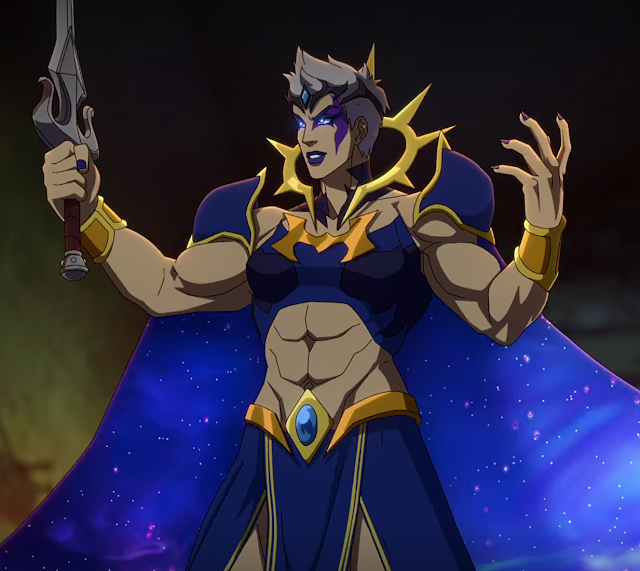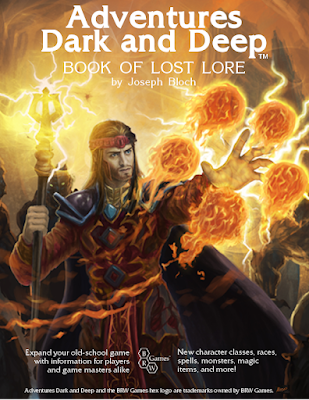I have talked about Tiamat since the earliest days of this blog. No surprise really given my love of mythology and my oldest son's obsession with dragons. It really is a natural fit for me. I was working on this post a lot over my Thanksgiving break and I went back and forth on a lot of different ideas. But circumstances came together and I finally decided, last night, what to post.
My oldest started Descent into Avernus this weekend for his 5e group. We thought that a nice early Christmas present would be the new Gargantuan Tiamat miniature.
 |
| The Tiamat "mini." Feiya and Larina for scale. |
This thing is, well, gargantuan!
Up till now, we had been using the Aspect of Tiamat, the D&D Icon of the Realms Tiamat, and the Mage Knight Apocalypse Dragon (more on that guy in a bit). The Queen of Dragons enters a lot into our games.
This also got me thinking about how I handle dragons in my Old-School games. In particular how I want to handle them in my Basic Bestiary. Over the years here I have experimented with various ways to present dragons so they are a constant challenge to any party regardless of size or levels. There have been some really good innovations over the years starting with the dragons in AD&D 2nd Ed and into 21st Century forms of D&D. I want to capture the best of the best design principles and also allow them to fit into the design I have already been using with my own monster stats.
I am not really 100% there yet.
But I am at a point where I can present unique dragons like Tiamat (or Tiâmat as I am presenting her). I still have a few issues to work out, but since I want to get my money's worth out of that figure here she is.
Tiâmat
Gargantuan Dragon (Evil)
Frequency: Unique
Number Appearing: 1 (1)
Alignment: Chaotic [Chaotic Evil]
Movement: 90' (30') [9"]
Fly 180' (60') [18"]
Swim 180' (60') [18"]
Armor Class: 0 [19]
Hit Dice: 30d8+240****** (375 hp)
Gargantuan: 30d20+240****** (555 hp)
To Hit AC 0: -2 (0) (+21)
Attacks: 5 bites + 1 tail lash or breath weapons or spell + special
Special:
Save: Monster 30
Morale: 12 (NA)
Treasure Hoard Class: Special
XP: 30,250 (OSE) 30,250 (LL)
Str: 30 (+7) Dex: 10 (+0) Con: 32 (+8) Int: 28 (+7) Wis: 24 (+5) Cha: 22 (+5)
Tiâmat is the mother of all dragons, good and evil. She was destroyed by her grandson Marduk and was cast out. Formerly a god she now represents the primordial chaos of the deep sea or even the infinite abyss. For this reason, she is often seen with the heads of all the major evil dragons, Black (Acid), Blue (Electric), Green (Poison), Red (Fire), and White (Cold). Fittingly, the mother of dragons makes her home in the depths of the Abyss in a layer known as Têhom, or the "deep". She is also considered to be the mother, or at least the Grandmother, of all evil and chaotic monsters.
Tiâmat can attack with all five heads per round. Each head can bite, use their respective breath weapons, or use spells. The bite attacks do 3d6+7 hp of damage each, but the individual heads cannot attack the same Medium-sized or smaller victim at the same time. A Large or larger-sized target can be attacked by two heads at the same time. Tiâmat can attack up to five (5) separate targets this way. Each head can also use their respective breath weapons doing 10d8 (45 hp) up to three times per day. She will typically attack with her breath weapons first, to overwhelm and awe her opponents and then resort to spells and bite attacks. Tiâmat believes that opponents need to be dealt with in the quickest, most deadliest, of ways.
Her aura of dragon fear is such that all, even true dragons, have to make a saving throw vs. magic or fall under the effects of a Cause Fear spell. This will affect all creatures regardless of HD/level. Each head can additionally cast a Magic-user/Wizard spell per round in lieu of a physical attack. The white head can cast 2 first-level spells and 1 second-level spell. The black head can cast 2 second-level and 1 third-level. The green head can cast 2 third-level and 1 fourth. The blue head can cast 3 fourth, 2 fifth, and 1 sixth-level. Finally, the red head can cast 3 sixth, 2 seventh, and 1 eighth-level spell. Tiâmat chooses her spells at the start of her day. She typically opts for spells of control, damage, and ones that can summon support. She does not need somatic or material components for her spells, they come naturally to her.
Due to her size, Tiâmat cannot make claw attacks while on the ground. She can attack with her foreclaws when she is flying or swimming. She is immune to charm, hold, mind-affecting magic, and sleep effects. She is additionally immune to all sorts of poison. She takes half damage from acid, cold, and fire. She also has 75% magic resistance.
As the Queen and Mother of Dragons Tiâmat she is served by five consorts. These are dragons of largest size and greatest age of their respective dragon types, White, Black, Green, Blue, and Red. Each one is utterly loyal to Tiâmat, failure to be anything but this will result in their immediate death and their skins put on display. Tiâmat can summon 2d6+1 evil dragons of any type once per day.
Tiâmat's home plane is known as Têhom, or the "deep." Here there are seven distinct areas that represent the preferred habitat of each of the five evil dragon types. Each one is governed over by her consorts. The sixth area is an ocean, so deep and so dark that no bottom has even been seen. Tiâmat makes her home here along with sea dragons of all sorts. It is rumored that the great dragon Leviathan also resides here. The seventh and last area is an island that Tiâmat often visits. Here her treasure horde can be found. This land is populated only by undead dragons.
Tiâmat as a Patron
Dragon Tradition Witches and Draconic Pact Warlocks take Tiâmat as their patron. Chaos mages also look to the Mother of Monsters as their patron, inspiration, and even Goddess. All dragons, good and evil, regard her as their mother or the first of their kind but only evil dragons and dragon-kin worship her.
--
Notes
I like this stat block quite a lot. I can look at it though and tell I still need to define my demons and dragons both a little better. There are ideas I want to express that I am currently not doing.
She is a Gargantuan creature. So because of that, I am going to be using my alternate HP calculations. A gargantuan creature uses a d20 for HP determination, not the standard d8. Even with this she is at 30 HD so in standard games she ends up with 375 hp. In my games that is boosted to 555 hp.
A bit on that HD. Yeah, she has 30 HD. She is big and bad and is not a monster you find on level 20 of some random dungeon. This flows from the level setting I was doing in One Man's God. Tiamat is not just on the top of the scale, she should be the top. A former Goddess now cast into the Abyss, that means two things for me. One she is powerful and two she should be a demon of some sort. She is obviously something more. I have her listed as "Gargantuan Dragon (Evil)" but she would certainly also be an Outsider or even a Fiend possibly. She could even be an Eodemon.
Alignment. I have been playing Tiamat as "Chaotic Evil" since I first started reading Chaos Theory back in the 90s. It always made far more sense to me. Plus she never really fit into the hierarchy of Hell as far as I was concerned. I do borrow a page from Paradise Lost and say she was there when the Devils fell. But that was only one of her lairs in the cosmos.
What about that Apocalypse Dragon? Well, I still want to get my money's worth out of him. So he has been redubbed as Leviathan. Fitting, given the history my games have had with him. I will need to revisit my stats for him though.
 |
| Tiâmat and Leviathan |
Links
Links to other Tiamat postings here on the Other Side.
- Tiamat on my Mind
- T is for Tharizdun and Tiamat
- Post 666
- Campaign Specific
- Dragonborn in Oerth
- Dragonslayers: An Epic Epic of Epicness
- Retrospective, Review and Refit: M3 Twilight Calling (BECMI)
- One Man's God
- OMG: Babylonian, Sumerian and Akkadian, Part 1
- OMG: Babylonian, Sumerian and Akkadian, Part 2
- Monstrous Monday: Scorpion Men
- Goddesses of the Witches


















